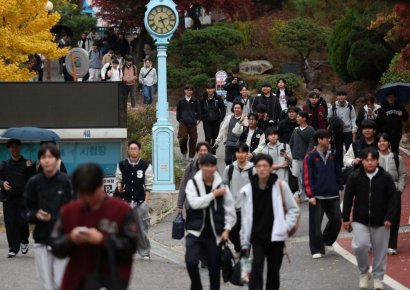US tariff bomb, China observes exchange rate response
If the value of the yuan falls, the United States will also suffer.
On the 27th, Asian stock markets showed a clear upward trend, led by the Greater China index. Stock markets in Japan and Taiwan fell, and other major indices such as India and Singapore remained flat.
According to Market Watch and Investing.com, the average stock price of Japan’s representative stock market, Nikkei 225 (Nikkei), closed at 38,134.97, down 307.03 points (0.80%). Topix, which fell at the opening, continued its downward trend until the close. The closing price closed at 2665.34, down 24.21 points (0.90%) from the previous trading day.
The Greater China stock market, which had remained flat despite U.S. President-elect Donald Trump’s “tariff bomb” comment the previous day, showed a clear rebound on this day, led by Hong Kong’s Hang Seng Index.
First, the Shanghai Composite Index closed at 3309.78, up 50.02 points (1.53%) from the previous trading day.
The CSI 300 index, which consists of the top 300 stocks listed on the Shanghai and Shenzhen stock exchanges, started lower on the day, but began to rebound around 10 o’clock when the morning trading volume was exhausted. The closing price was 3907.04, up 66.86 points (1.74%) from the previous trading day.
Taiwan’s stock market, on the other hand, fell. The stock market, which continued to decline from opening to closing, closed at 22,334.78, down 343.98 points (1.52%) from the previous trading day.
Hong Kong’s Hang Seng Index had the largest increase among major Asian stock markets on this day. As of 4:41 PM our time, closing trading is in progress at 19,598.95, up 442.88 points (2.305%) from the previous trading day. The rise expanded in the afternoon, and the buying trend dominated the overall trading volume.
At the same time, India’s Sensex index is maintaining a strong trend, up 0.43%, and Singapore’s ST Composite Index is maintaining a weak trend, down 0.11%.
The Greater China stock market, which had held steady despite the news of tariff bombs from the United States, began a full-fledged rebound on this day.
Previously, U.S. President-elect Donald Trump announced plans to impose tariffs on three countries, including China, through social networking services (SNS). However, after these remarks, concerns followed that a ‘currency war’ between the United States and China could intensify and that the United States could be hit as much as China.
The New York Times raised the possibility of China’s artificial yuan devaluation, saying, “China has powerful tools to respond to President-elect Trump’s threat of new tariffs on Chinese products.”
He continued, “If China starts a full-scale currency war, it could pose a strong risk not only to China but also to the United States.”
There is already a precedent for the Chinese government to respond with this so-called ‘strategic yuan devaluation’ when the United States imposed high tariffs on China in 2018 and 2019 during Trump’s first term in office.
The news that the decline in Chinese companies’ profits had slowed was also good news.
On this day, Hong Kong’s South China Morning Post (SCMP) said, “The Hong Kong stock market, which had hit its lowest point in two months, has begun to rebound following the release of a report that the decline in profits of major Chinese companies slowed last month. There are some concerns about the resilience of the Chinese economy.” “It has been resolved,” the report said.
Some analysts say that if full-scale pressure from the United States begins, the Chinese authorities will take policy action. “China and Hong Kong stock markets will bring more volatility in the future,” said Zhang Shida, an analyst at Guoyuan Securities in Shenzhen. “China’s fiscal policy and economic driving force are key factors that can determine the market direction.”
Meanwhile, on this day, KOSPI and KOSDAQ closed down 0.69% and 0.17%, respectively.
![[아시아증시] Greater China stock market counterattacks amid policy expectations… Hang Seng up 2% [아시아증시] Greater China stock market counterattacks amid policy expectations… Hang Seng up 2%](https://jenniferlarsenphoto.com/wp-content/uploads/sites/6293/2020/03/rockleigh-wedding-nj-southern-california-wedding-photographer-photo_0016.jpg)
**What are the potential long-term consequences of an escalating trade war between the U.S. and China for the global interconnectedness of financial markets and supply chains?**
## World Today News Interview: US Tariff Threats and the Asian Markets
**Introduction:**
Welcome to World Today News. Today we’re discussing the recent tariff threats made by the United States against China and its ripple effect on global markets. To help us understand the intricacies of this developing situation, we’re joined by two esteemed guests. Dr. Amelia Chen, Professor of Economics at Harvard University, specializing in Sino-American trade relations, and Mr. David Lee, Senior Analyst at Global Insights, renowned for his expertise in Asian financial markets.
**Section 1: The Tariff Threat and Potential Economic Fallout**
**Interviewer:** Dr. Chen, the article mentions US President-elect Trump’s “tariff bomb.” Can you help our viewers understand the potential economic consequences of these tariffs for both the US and China?
**Dr. Chen:**
(Answer focusing on the potential impact on trade, industry sectors, consumer prices, and overall economic growth in both countries.)
**Interviewer:** Mr. Lee, how do you see the currency markets reacting to this volatile situation? Specifically, what’s your take on the possibility of a ‘currency war’, as mentioned in the article, and its global implications?
**Mr. Lee:**
(Answer discussing potential currency devaluation strategies, the role of central banks, and the impact on international trade and investment.)
**Section 2: Asian Market Response and Investor Sentiment**
**Interviewer:** The article highlights contrasting trends within Asian markets. We see Hong Kong’s Hang Seng Index surging while Japan’s Nikkei 225 shows a decline. Mr. Lee, can you shed some light on these diverging trends and what factors might be driving them?
**Mr. Lee:**
(Answer discussing the unique vulnerabilities and strengths of different Asian economies, investor sentiment towards specific markets, and the role of regional geopolitical dynamics.)
**Interviewer:** Dr. Chen, what’s your assessment of the long-term impact of these tariff threats on investor confidence in the Asian region?
**Dr. Chen:**
(Answer focusing on the potential for sustained volatility, the attractiveness of different investment destinations, and the importance of diversifying portfolios.)
**Section 3: China’s Response and Policy Options**
**Interviewer:** Dr. Chen, the article mentions the possibility of China responding with a “strategic yuan devaluation.” Can you elaborate on what this strategy entails and its potential effectiveness in countering US tariffs?
**Dr. Chen:**
(Answer explaining the mechanics of currency devaluation, its potential impact on trade competitiveness, and the potential risks and downsides associated with this move.)
**Interviewer:** Mr. Lee, what other policy options might China consider in response to these tariffs? And how effectively could these measures mitigate the negative economic impact?
**Mr. Lee:**
(Answer exploring alternative policy measures like retaliatory tariffs, trade diversification, investment in domestic industries, and the potential effectiveness of each option.)
**Section 4: Looking Ahead – Future Scenarios and Global Implications**
**Interviewer:**
Both of you have painted a complex picture of the economic landscape. Looking ahead, what are the most likely scenarios you foresee?
**Dr. Chen:**
(Answer exploring potential scenarios ranging from negotiated settlements to prolonged trade wars, and the respective impact on global economic growth and stability.)
**Mr. Lee:**
(Answer complementing Dr. Chen’s analysis by providing insights into the potential impact on specific sectors, investment flows, and the overall risk environment for global investors.)
**Interviewer:**
Dr. Chen and Mr. Lee, thank you for sharing your valuable insights. This is indeed a crucial moment in global economic affairs. We hope this discussion has shed some light on the complexities of the situation and provided our viewers with a more informed perspective.

